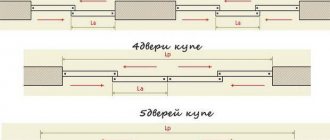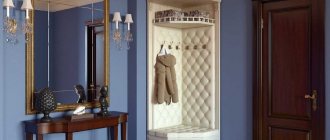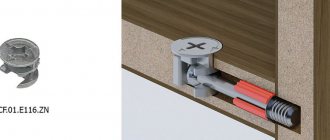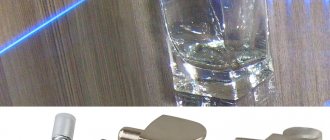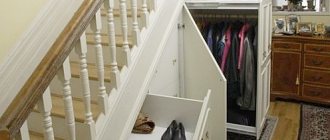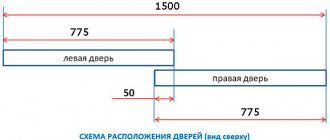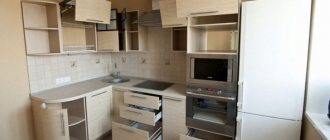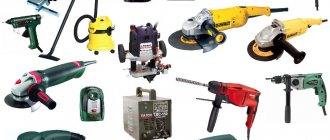Andrey
8103 0 1
Andrey March 2, 2018 Specialization: facade finishing, interior finishing, construction of dachas, garages. Experience of an amateur gardener and gardener. We also have experience in repairing cars and motorcycles. Hobbies: playing the guitar and many other things that I don’t have time for :)
If you are planning to repair an old cabinet or make a new one from scratch, you will definitely be faced with the choice and installation of a rod. At first glance, this is a simple task, but in reality it contains many nuances. Therefore, I suggest you familiarize yourself with them, which will allow you to independently arrange a comfortable and reliable hanger in your closet.
The rod is a necessary element of any wardrobe
Longitudinal rods for clothing
The familiar and familiar clothes hanger in the form of a round or oval pipe can even be backlit. When choosing, you should pay attention to the strength of the fastening to the sides of the wardrobe.
If the niche for hangers is more than 60-70 cm in length, then it is better to opt for a chrome-plated round pipe with a diameter of 25 mm (Joker system). Thanks to the presence of various stops and holders, you can make an additional stop for the longitudinal bar so that it does not sag from the weight of outerwear placed on hangers. And also make a two-level storage system for short and long clothes.
- The advantage of rods fixed along the length of the wardrobe is obvious: the hangers hanging on it are turned sideways and you can immediately see where the clothes are hanging.
- The only drawback is that hangers for a wardrobe of this type require an appropriate depth, about 50-65 cm. And they are not suitable for shallow boxes (for example, in narrow hallways).
How to install a clothes rail in a closet
The installation method depends on the furniture parameters. If the crossbar needs to be placed in a narrow cabinet, it is better to use a longitudinal fastening. If the cabinet is deep enough, you can perform a transverse installation.
Installation of the longitudinal crossbar
First option:
- Place one end of the rod blank in the holder, measure the distance from the cut of the blank to the plane where the holder is attached to the wall. In our case it turned out to be 3 mm.
- Do the same on the other side.
- Measure the distance from wall to wall (w), subtract the sum of the distances to the holder from the resulting number. This will give you the length of the rod (d).
- Saw off the steel tube (I recommend using a 25 mm universal Joker pipe) with a grinder or a hand hacksaw to size.
- Calculate the distance from the back wall of the closet to the rod: usually 25–28 cm (depending on the size of the clothes and the dimensions of the hangers).
- Make holes for the wall socket with a screwdriver or drill (depending on the cabinet material) and secure the holders with 4x16 mm screws.
- Place the crossbar on them.
A ready-made kit for installing a crossbar in a closet can be bought in a store
Consider the distance from the cabinet ceiling to the rod holder - 4–5 cm.
Expert opinion
Alexander Didenko
Furniture assembler at Mabaks
Sometimes, for structural strength, you can additionally install a mount on the ceiling of the cabinet to prevent the rod from breaking.
Additional mount for ceiling crossbar
Second option.
Method of installing a wooden crossbar in a wardrobe.
- Drill holes at the ends and in the walls of the cabinet.
- Place the beam against the wall.
- From the outside, drill the self-tapping screw so that it fits into the hole in the end.
Such fasteners are dangerous because the crossbar can crack along its entire length when drilled.
Installing the crossbar
In the transverse position, a retractable microlift rod is often installed. It is attached to four screws screwed into the top of the cabinet. This mechanism is applicable for light items.
The crossbar is secured with four screws to the top of the cabinet in a convenient location
If you are going to hang outerwear and at the same time want to install it across the closet, choose a pipe not with a microlift, but a standard shape: oval or round. It will be more reliable.
A rod with a rigid mount has an increased load
Cross pull-out hanger for wardrobe
A clothes hanger with a transverse (perpendicular to sliding door) fastening is designed for narrow closets. Has many configurations:
- With fastening to the back of the shelf and the side of the cabinet.
- Be stationary, equipped with a retractable or folding mechanism.
- Externally it takes the form of a “loop”, “rake” and “fan”.
- Equipped with an elevator and other types of transformation.
Cross hangers for sliding wardrobes are used not only for hangers. They are convenient for hanging bags, belts, scarves and other clothing accessories. Can be supplemented with hooks, holders, stops and clamps for convenience.
They have one drawback - the relative fragility of the structure and the tendency to abrasion in places of increased friction during extension.
Types of rods
Varieties of design
Depending on the type of design and purpose, cabinet rods are divided into the following types:
Types of closet rods
Next, let's take a closer look at all their types:
| Illustrations | Description |
| Microlift. A microlift, which is also popularly called a trombone, is capable of increasing in length, i.e. has a retractable mechanism. Microlifts are designed for narrow cabinets, i.e. the depth of which does not exceed 40-50 cm. They are installed not along the cabinet, as usual, but across it. This, of course, complicates access to clothes hanging from the back wall of the furniture. To make it easier, you can simply pull the bar forward. | |
| Pantograph. A pantograph, unlike a microlift, is capable of changing the height of the rod, i.e. can go down and up. This need usually arises in built-in wardrobes, in which the hangers are located at different levels. The pantograph performs the same tasks as a microlift - it provides convenient access to clothes. Such a device is rarely found in ordinary cabinet cabinets. | |
| For trousers. A trouser hanger is usually installed below, under the outerwear bar. It consists of many crossbars on which you can lay your trousers so as not to wrinkle them. It must be said that the designs and methods of fastening such a rod are different, but the crossbars are always located across the cabinet. This ensures easy access to the trousers. | |
| For ties. The design of a tie and belt bar resembles a trouser hanger - it also has many crossbars. However, it differs in its miniature size. Often it is provided with a telescopic mechanism, which allows you to install the hanger across the cabinet and pull it forward like a microlift. In fact, this is an ordinary microlift, which differs from the one described above only in purpose.
| |
| Crossbar. The crossbar, which is also simply called a pipe, is the simplest and most common type of barbell. Its name speaks for itself - a design in the form of a pipe with fasteners, which, as I already said, are fixed on the walls of the cabinet. Depending on the cross-sectional shape, the crossbars are divided into two types:
| |
| With backlight. It has the same design as a regular crossbar, but, as you might guess, it is equipped with lighting. As a rule, for this purpose, perforations are made in the crossbar and LEDs are installed, which provide lighting inside the cabinet. Sometimes there are models with built-in fluorescent lamps. The backlight is usually controlled by buttons located on the crossbar itself. |
Manufacturing materials
Rods are made from different materials:
| Illustrations | Description |
Wooden. At one time, only wooden hangers of oval and round sections were installed in furniture. They are quite strong and durable. However, they have several disadvantages:
| |
| Aluminum. Aluminum hangers are not afraid of moisture and weigh much less than wood and steel. However, they cannot withstand heavy loads. Therefore, they are usually used for lightweight clothing such as shirts, dresses, trousers, etc. If you need a coat hanger, look for products made from more durable materials. | |
| Iron. Iron tubes have become the most popular lately. They are made from durable steel grades and coated with a layer of chrome. As a result, the products are practical and able to withstand heavy loads. Therefore, they are great for outerwear. The only negative is that the metal hooks of the tramples damage the chrome plating over time. This leads to the formation of corrosion. This drawback especially concerns cheap fittings.
| |
| Plastic. Plastic products are intended exclusively for lightweight items such as trousers, shirts, ties, etc. Therefore, most often they are installed at the bottom of the cabinet. It must be said that plastic models are rare. As a rule, they are installed in the most budget cabinets, since they are low in cost. |
Lift rod (pantograph)
The elevator mechanism can be equipped with both transverse and longitudinal bars for hangers. Such a hanger is usually placed right under the ceiling (the roof of the closet), and, if necessary, is lowered using a special handle. Usually about 170 cm in height are left under the pantograph so that the longest outerwear does not wrinkle.
- One of the advantages of using pantographs is the ability to make the most efficient use of the internal space of the wardrobe. But be careful when planning corner and U-shaped configurations: the pantograph needs to go down somewhere, so the space in front of it must be free and sufficient.
- The disadvantage is that the mechanism wears out relatively quickly, especially if the pantograph is used to place heavy outerwear (fur coats, sheepskin coats, winter jackets).
Well, this thing with hangers on it. What's her name?
A hanger bar, a stick on which to hang clothes.
What did your family call that thing in the wardrobe? Well, this one: New knowledge can sometimes be shocking. At one time I was shocked that this thing was called a hanging bar. Moreover, as it turned out, there is a separate concept of “hung”, this is the following construction:
But let's return to our barbell. It’s good to know more about her; it turns out she’s hiding secrets! First of all, such rods are longitudinal and transverse, or end. Longitudinal ones are the most comfortable, in fact, they are exactly like that in the photographs above.
An important nuance is the length of the longitudinal rod. If it is more than a meter, the weight of the clothing becomes too much, which can cause the rod to become deformed or even crack the closet wall to which the rod is attached. Therefore, in this case, a vertical support is placed in the middle. A support for heavy outerwear in the closet is also useful. Here, for example, is a diagram of the insides of such a cabinet:
It’s a transverse one, and the problem with it is that things hanging in the depths are difficult to get out, and if the transverse hanging rod is long enough, then you risk losing some things altogether. Look how modern designers have solved this issue.
Do you see? The rod is short, and it extends so that you don’t have to literally climb inside the closet to get clothes.
There is another amazing invention in which the hanging rod extends. This is the so-called lift bar, or furniture pantograph. A very useful thing if you have high ceilings and are wondering what to place in the top of the cabinet.
Typically, lift rods hold clothes that are rarely used, such as evening dresses. You can also put winter things there in the summer, and summer things in the winter.
Pantographs can be mechanical or electrically driven. Mechanical ones will require some effort from you, they work like this:
Thus, you need to place the pantograph so that it is convenient for you to reach the bottom of this black thing that goes down.
The electric drive is more convenient: you just need to press a button. But the price of such a device is inhumane.
Pantographs also sometimes come in interesting designs, for example, these:
Source
Pants or "skirts"
Trouser hangers with special crossbars parallel to each other are commonly called trouser hangers. However, it is convenient to hang not only trousers on them, but also skirts, as well as any other clothes that need to be stored in a suspended state. Thanks to special clips or the very configuration of the hanging compartments, wardrobe items are securely fixed and do not slip off.
Pants are most often equipped with a retractable mechanism. They can have a frame structure built into a cabinet niche with fastening to the sides, similar to a drawer. And also attached to one side of the partition or to the back of the shelf.
- The advantage is obvious - things do not wrinkle on such trouser hangers, and no additional hangers are required.
- Among the disadvantages, it is worth highlighting the bulkiness of the trouser design itself. It takes up extra space in the closet, and things don’t hang on it as tightly as on a rod.
Purpose and features
To ensure that the wardrobe is easy to use and does not allow clothes to become wrinkled, it is provided with a hanger. Its main element is a bar (crossbar), on which trempels (hangers) or clothing itself are usually hung. The crossbar is a pipe that is most often attached to the walls of furniture.
Often, several rods are installed at different levels in one section of the cabinet. This saves space and reduces the number of shelves. The latter in this case will be occupied only with shoes and all sorts of small things.
Barbells allow you to reduce the number of shelves to a minimum
The main requirement for any barbell is load-bearing capacity. It must support the weight of all the clothes that will hang on it. In addition, the hanger should be positioned so that the closet space is used efficiently.
Brackets for scarves, ties and belts
Not only clothes, but also other wardrobe items can be stored hanging. Special brackets and hangers can be attached independently or offered as an additional accessory to another hanger for a sliding wardrobe - a longitudinal rod.
Hangers for a vacuum cleaner and iron are also on sale - they will allow you to organize a “utility corner” inside a dedicated compartment of a closet or dressing room.
Main varieties
As for the size and materials from which pantographs are made, there is nothing complicated here. Select the size according to the size of your wardrobe, choose the material that suits you.
Separately, it is worth considering the principle of operation. Pantographs for installation in wardrobes can be:
- with electrical control;
- with mechanical, manual control.
The installation of the first model is complicated, and accordingly they are more expensive than mechanical ones. But electrically controlled models are extremely easy to use; even a small child can handle them.
Shoe hanger
Some people are more accustomed to storing shoes in boxes, others select drawers or add mesh shelves to the wardrobe. In addition to these options, it is also possible to store shoes in a suspended state so that the tops of the boots do not wrinkle - using special hangers-holders.
As a rule, when developing the internal filling of a sliding wardrobe, several types of hangers are used. Many manufacturers offer a basic set of rods and hooks, trying to maximize the useful space of the cabinet when planning, combining it with shelves and drawers.
Oval rod
The oval bar is a classic example of a clothing bar.
It is fixed on rod holders designed for fastening an oval rod inside the cabinet. Such a rod, due to its oval shape, is more rigid and therefore can withstand higher lateral loads compared to a round rod. For example, wearing a lot of heavy outerwear can put a fair amount of pressure on the barbell. And just an oval bar can better cope with such a load. Although, of course, it all depends on the length! If the length exceeds 1.5 meters, then it is better to play it safe and use additional fastenings.
Installation of a rod with a ceiling mount
If self-tapping screws, hangers, or brackets are chosen for fastening, then installing the rod using the ceiling method, to the ceiling, is done as follows:
- mark the place of fixation;
- drill holes;
- screws or screws are screwed in.
Anchor bolts are installed as follows:
- Make holes of the required diameter.
- The fastener is secured by driving or screwing.
There are many designs of rods that allow you to hang clothes evenly, compactly and maintain their presentable appearance. Special devices have been developed for each type of clothing.
Did you manage to solve your problem using the recommendations from the article?
Yes!
46.06%
No. More answers required. I'll ask in the comments now.
37.9%
Partially. There are still questions. I'll write in the comments now.
16.03%
Voted: 343
What to look for when choosing
When choosing floor structures, you should take into account certain rules that allow you to purchase a truly optimal option for any hallway:
- it must correspond in appearance to the style and color scheme of the hallway;
- must be stable, since it is usually intended for storing outer clothing; it must not warp or fall under its weight;
- should not interfere with walking around the room, so if the corridor is an excessively small room, then you should not choose a large hanger;
- must accommodate all the necessary things, so when choosing a design, take into account how many people will store their clothes on it;
- the material of manufacture must be safe;
- the cost should not be excessively high, but this does not apply to forged structures that have an unusually attractive appearance.
Thus, with the right choice of product, an excellent decoration of the corridor will be provided, and at the same time a special place will be created for storing things.
There are many types of hangers used for a dressing room. They differ in size, appearance, material of manufacture and other factors. When choosing, you should take into account the style of the corridor, as well as the installation location of the product. Not only is it guaranteed to create multi-functional storage space, but it also provides an attractive decoration for the hallway.
Dimensions of clothing rails
The length of the rod depends on the width of the cabinet. For example, in a standard wardrobe, its length does not exceed a meter.
The average length of retractable bars is from 25 cm to 50 cm.
The size of the Ikea retractable structure is 50x35 cm. It is convenient for shirts and light items.
You should not install a crossbar longer than one and a half meters, as it may not hold up and break under the load of clothing. The maximum length for round rods is 1.5 m.
Oval bars are stronger than round ones, so they can be made longer. There are also telescopic rods with variable size and a load of up to 10 kg. Example on video.
Dimensions of clothing rails
To choose the optimal location for the rod, you need to start from two factors - the width and depth of the closet section intended for hangers with clothes. Longitudinal installation is possible only in cabinets with a depth of at least 530 mm. Even if the cabinet depth is 480 or 460 mm, it will not allow standard hangers to be placed longitudinally.
READ How to install a roof rack on a Golf 3
In closets with a depth not exceeding 50-55 cm, hangers with clothes can only be placed parallel to the back wall of the closet. Standard lengths of retractable rods are 500 and 250 mm.

